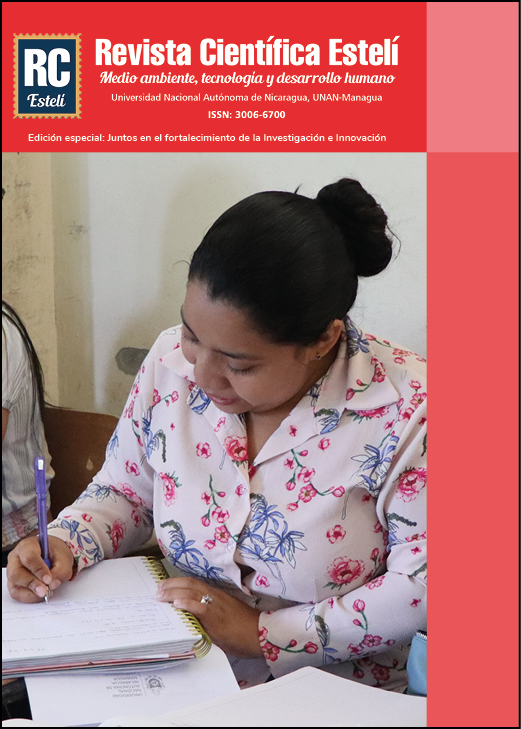Artificial intelligence (AI) in university education. Challenges for professors of UNAN-Managua/CUR Estelí in its use to facilitate learning processes
DOI:
https://doi.org/10.5377/esteli.v13i2.19807Keywords:
Artificial intelligence, digital technological competence, teaching activitiesAbstract
Artificial intelligence (AI) and its applications are increasingly high-impact tools and their implementation in the various branches of science, and in education, especially at the university level, emerges as a strategy that allows teachers to streamline their work, from the fact of planning, facilitation of learning and evaluation, but in turn is a challenge for them, who must have the digital technology skills to take advantage of it. This article focused on determining the mastery and use of AI applications by academics of the National Autonomous University of Nicaragua, Managua UNAN Managua, of the Estelí Regional University Center, CUR Estelí, and how they are used by them in planning, class facilitation, evaluations, report writing, etc. The study was based on the use of AI applications by academics of the National Autonomous University of Nicaragua, Managua UNAN Managua, of the Estelí Regional University Center, CUR Estelí. The study was based on a mixed research approach, using qualitative and quantitative techniques and instruments to obtain data, collected through an online survey and interviews with key informants, as well as documentary analysis of different articles related to the topic. As a result, most of the professors use AI in a basic way, to elaborate some material or work guides, but it is not implemented to develop contents or make evaluations of the learning process, this because they have not developed the digital technological competence and there is some fear in using it with the students. Concluding in this way that it is a challenge for professors to incorporate AI in their teaching activities and all that this implies.
Downloads
References
Alvarado Rojas, M. E. (2015). Una mirada a la inteligencia artificial. Revista Ingeniería, Matemáticas y Ciencias de la Información, 2(3), 27-31.
Armada Pacheco, J. M. (2023). Desafíos de la docencia universitaria ante la educación 4.0. Revista multidisciplinaria del saber, 1-14. doi:https://doi.org/10.61286/e-rms.v1i.11
Artetxe, M. (23 de Agosto de 2023). “No existe una definición exacta de lo que es la Inteligencia Artificial”. Boulevard. (R. Euskadi, Entrevistador) Obtido de https://www.eitb.eus/es/radio/radio-euskadi/programas/boulevard/audios/detalle/9291863/no-existe-definicion-exacta-de-lo-que-es-inteligencia-artificial/
Ayuso-del Puerto, D., & Gutiérrez-Esteban, P. (2022). La Inteligencia Artificial como recurso educativo durante la formación inicial del profesorado. RIED. Revista Iberoamericana de Educación a Distancia, 25(2), 347-362. doi:https://doi.org/10.5944/ried.25.2.32332
Bellettini Vela, G., Mora Naranjo, B. M., Ríos Quinte, R. J., Egas Villafuerte, V. P., & López Velasco, J. E. (2024). Inclusión de la inteligencia artificial en la docencia universitaria. LATAM Revista Latinoamericana de Ciencias Sociales y Humanidades, 5(1), 1-14. doi:https://doi.org/10.56712/latam.v5i1.1642
Cabanelas Omil, J. (2019). Inteligencia artificial ¿Dr. Jekyll o Mr. Hyde? Revista Mercados y Negocios, 1(40), 5-22. Obtido de https://www.redalyc.org/journal/5718/571860888002/html/
Chávez Maciel, F. J., Carreto Arellano, C., Cruz Miranda, C. S., Ramos Quiroz, J. M., Panchi Cosme, A., Ávalos Bravo, R. V., . . . Argüello Moreno, M. E. (2020). Desarrollos exponenciales. - Innovación en educación y formación. Los docentes de educación media y superior ante los desafíos digitales de la 4ª Revolución Industrial y la pandemia del COVID-19. Un estudio de caso. Lisboa, Portugal. Obtido de https://encuentros.virtualeduca.red/storage/ponencias/lisboa2020/Bj6wfHUmKYw9ZtMGcQUFar3wMHeHNxZJnQUowCiO.pdf
González-Sánchez, J. L., Villota-Garcia, F. R., Moscoso-Parra, A. E., Garces-Calva, S. W., & Bazurto-Arévalo, B. M. (2023). Aplicación de la Inteligencia Artificial en la Educación Superior. Revista Científica Dominio de las Ciencias, 9(3), 1097-1108. doi:10.23857/dc.v9i3.3488
Hernández Sampieri, R., Fernández Collado, C., & Baptista Lucio, M. d. (2014). Metodología de la Investigación (Sexta ed.). McGraw-Hill Interamericana de España S.L.
Hintze, A. (14 de Noviembre de 2016). Understanding the four types of AI, from reactive robots to self-aware beings. Obtido de Understanding the four types of AI, from reactive robots to self-aware beings: https://theconversation.com/understanding-the-four-types-of-ai-from-reactive-robots-to-self-aware-beings-67616
ICCSI. (2023). Según Russell y Norvig, ¿cuántos tipos de inteligencia artificial existen? (Tableau, Editor) Obtido em 10 de Julio de 2024, de Tableau: https://www.tableau.com/es-mx/data-insights/ai/tipos-de-inteligencia-artificial
Lengua Cantero, C., Bernal Oviedo, G., Flórez Barboza, W., & Velandia Feria, M. (2020). Tecnologías emergentes en el proceso de enseñanza-aprendizaje: hacia el desarrollo del pensamiento crítico. Revista Electrónica Interuniversitaria de Formación del Profesorado (REIFOP) , 23(3), 83-98. doi:https://doi.org/10.6018/reifop.435611
Salmerón Moreira, Y. M., Luna Alvarez, H. E., Murillo Encarnacion, W. G., & Pacheco Gómez, V. A. (2023). El futuro de la Inteligencia Artificial paa la Educación en las Instituciones de Educación Superior. CONRADO Revista pedagógica de la Universidad de Cienfuegos, 19(23), 27-34.
Vera, F. (2023). Integración de la Inteligencia Artificial en la Educación Superior: Desafíos y Oportunidades. Revistra electrónica Transformar, 4(1), 17-34.
Downloads
Published
Issue
Section
License
Copyright (c) 2024 Revista Científica Estelí

This work is licensed under a Creative Commons Attribution-NonCommercial-ShareAlike 4.0 International License.

